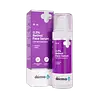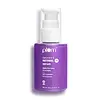What's inside
What's inside
 Key Ingredients
Key Ingredients

 Benefits
Benefits

 Concerns
Concerns

 Ingredients Side-by-side
Ingredients Side-by-side

Water
Skin ConditioningEthylhexyl Methoxycrylene
Skin ConditioningDiethylhexyl Carbonate
EmollientEthoxydiglycol
HumectantGlycerin
HumectantTetrahexyldecyl Ascorbate
AntioxidantDimethylmethoxy Chromanol
AntioxidantPhysalis Angulata Extract
Skin ProtectingCaprylic/Capric Triglyceride
MaskingCyclopentasiloxane
EmollientPhenyl Trimethicone
Skin ConditioningDimethiconol
EmollientC12-15 Alkyl Benzoate
AntimicrobialDimethicone Crosspolymer
Emulsion StabilisingHydroxyethyl Acrylate/Sodium Acryloyldimethyl Taurate Copolymer
Emulsion StabilisingPhenoxyethanol
PreservativeEthylhexylglycerin
Skin ConditioningMethyl Glucose Sesquistearate
EmollientBehenyl Alcohol
EmollientTrisodium Ethylenediamine Disuccinate
Pentylene Glycol
Skin Conditioning4-T-Butylcyclohexanol
MaskingPentaerythrityl Distearate
EmulsifyingBHT
AntioxidantRetinol
Skin ConditioningPolysorbate 20
EmulsifyingSodium Metabisulfite
AntioxidantWater, Ethylhexyl Methoxycrylene, Diethylhexyl Carbonate, Ethoxydiglycol, Glycerin, Tetrahexyldecyl Ascorbate, Dimethylmethoxy Chromanol, Physalis Angulata Extract, Caprylic/Capric Triglyceride, Cyclopentasiloxane, Phenyl Trimethicone, Dimethiconol, C12-15 Alkyl Benzoate, Dimethicone Crosspolymer, Hydroxyethyl Acrylate/Sodium Acryloyldimethyl Taurate Copolymer, Phenoxyethanol, Ethylhexylglycerin, Methyl Glucose Sesquistearate, Behenyl Alcohol, Trisodium Ethylenediamine Disuccinate, Pentylene Glycol, 4-T-Butylcyclohexanol, Pentaerythrityl Distearate, BHT, Retinol, Polysorbate 20, Sodium Metabisulfite
Water
Skin ConditioningAloe Barbadensis Leaf Juice
Skin ConditioningSucrose
HumectantPropanediol
SolventSqualane
EmollientIsodecyl Neopentanoate
EmollientRetinyl Palmitate
Skin ConditioningMalus Domestica Fruit Cell Culture Extract
Skin ConditioningHydrolyzed Rice Protein
Skin ConditioningHydrolyzed Pea Protein
EmollientGlycine
BufferingProline
Skin ConditioningHydrolyzed Sodium Hyaluronate
Skin ConditioningHydrolyzed Psoralea Corylifolia Extract
Skin ConditioningBenzyl Alcohol
PerfumingHydroxyacetophenone
AntioxidantCaprylyl Glycol
EmollientXanthan Gum
EmulsifyingGlycerin
HumectantLecithin
EmollientPhenoxyethanol
PreservativeSorbitol
HumectantCyclodextrin
AbsorbentHydroxyethyl Acrylate/Sodium Acryloyldimethyl Taurate Copolymer
Emulsion StabilisingIsohexadecane
EmollientPolysorbate 60
EmulsifyingSodium Gluconate
Skin ConditioningSodium Polyacryloyldimethyl Taurate
Emulsion StabilisingAmmonium Acryloyldimethyltaurate/Vp Copolymer
Water, Aloe Barbadensis Leaf Juice, Sucrose, Propanediol, Squalane, Isodecyl Neopentanoate, Retinyl Palmitate, Malus Domestica Fruit Cell Culture Extract, Hydrolyzed Rice Protein, Hydrolyzed Pea Protein, Glycine, Proline, Hydrolyzed Sodium Hyaluronate, Hydrolyzed Psoralea Corylifolia Extract, Benzyl Alcohol, Hydroxyacetophenone, Caprylyl Glycol, Xanthan Gum, Glycerin, Lecithin, Phenoxyethanol, Sorbitol, Cyclodextrin, Hydroxyethyl Acrylate/Sodium Acryloyldimethyl Taurate Copolymer, Isohexadecane, Polysorbate 60, Sodium Gluconate, Sodium Polyacryloyldimethyl Taurate, Ammonium Acryloyldimethyltaurate/Vp Copolymer
Ingredients Explained
These ingredients are found in both products.
Ingredients higher up in an ingredient list are typically present in a larger amount.
Glycerin is already naturally found in your skin. It helps moisturize and protect your skin.
A study from 2016 found glycerin to be more effective as a humectant than AHAs and hyaluronic acid.
As a humectant, it helps the skin stay hydrated by pulling moisture to your skin. The low molecular weight of glycerin allows it to pull moisture into the deeper layers of your skin.
Hydrated skin improves your skin barrier; Your skin barrier helps protect against irritants and bacteria.
Glycerin has also been found to have antimicrobial and antiviral properties. Due to these properties, glycerin is often used in wound and burn treatments.
In cosmetics, glycerin is usually derived from plants such as soybean or palm. However, it can also be sourced from animals, such as tallow or animal fat.
This ingredient is organic, colorless, odorless, and non-toxic.
Glycerin is the name for this ingredient in American English. British English uses Glycerol/Glycerine.
Learn more about GlycerinThis is a synthetic polymer. It helps improve the texture of products by adding thickness and gel-like feel.
It is also an emulsifer, meaning it prevents ingredients such as oil and water from separating. It also helps evenly disperse other ingredients.
Phenoxyethanol is a preservative that has germicide, antimicrobial, and aromatic properties. Studies show that phenoxyethanol can prevent microbial growth. By itself, it has a scent that is similar to that of a rose.
It's often used in formulations along with Caprylyl Glycol to preserve the shelf life of products.
Water. It's the most common cosmetic ingredient of all. You'll usually see it at the top of ingredient lists, meaning that it makes up the largest part of the product.
So why is it so popular? Water most often acts as a solvent - this means that it helps dissolve other ingredients into the formulation.
You'll also recognize water as that liquid we all need to stay alive. If you see this, drink a glass of water. Stay hydrated!
Learn more about Water